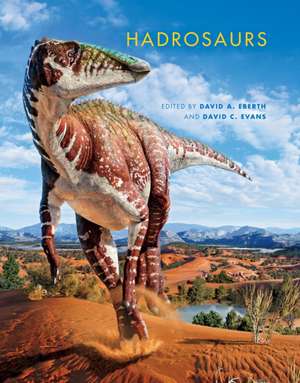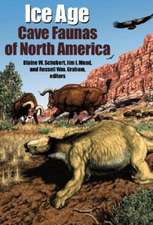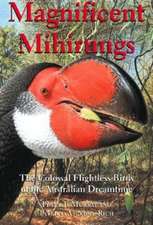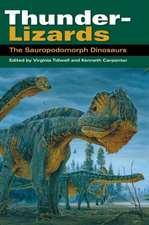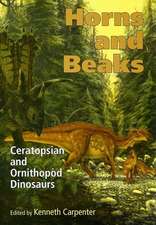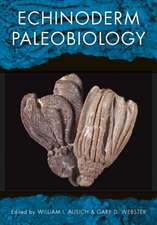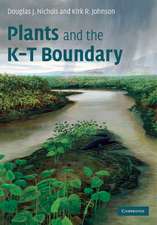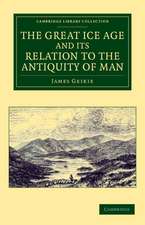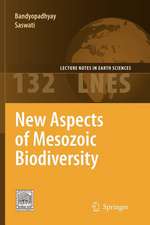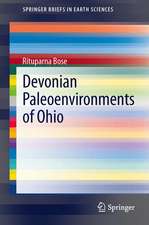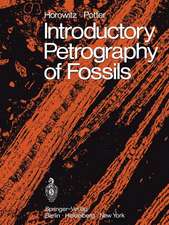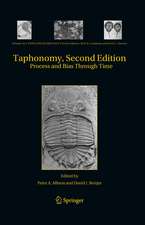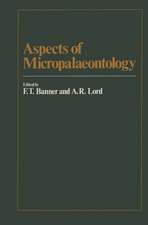Hadrosaurs: Life of the Past
Autor David A. Eberth, Michael J. Benton, David C. Evans, Andrey Atuchin, Karl T. Batesen Limba Engleză Hardback – 4 noi 2014
Din seria Life of the Past
-
 Preț: 300.55 lei
Preț: 300.55 lei -
 Preț: 221.08 lei
Preț: 221.08 lei - 15%
 Preț: 433.14 lei
Preț: 433.14 lei -
 Preț: 281.32 lei
Preț: 281.32 lei -
 Preț: 334.12 lei
Preț: 334.12 lei -
 Preț: 261.11 lei
Preț: 261.11 lei -
 Preț: 383.09 lei
Preț: 383.09 lei -
 Preț: 375.72 lei
Preț: 375.72 lei -
 Preț: 349.91 lei
Preț: 349.91 lei -
 Preț: 323.95 lei
Preț: 323.95 lei -
 Preț: 301.56 lei
Preț: 301.56 lei - 19%
 Preț: 374.26 lei
Preț: 374.26 lei - 19%
 Preț: 394.66 lei
Preț: 394.66 lei -
 Preț: 176.15 lei
Preț: 176.15 lei -
 Preț: 275.60 lei
Preț: 275.60 lei - 15%
 Preț: 551.48 lei
Preț: 551.48 lei -
 Preț: 261.16 lei
Preț: 261.16 lei -
 Preț: 392.41 lei
Preț: 392.41 lei -
 Preț: 303.60 lei
Preț: 303.60 lei -
 Preț: 411.29 lei
Preț: 411.29 lei -
 Preț: 239.32 lei
Preț: 239.32 lei -
 Preț: 330.52 lei
Preț: 330.52 lei -
 Preț: 341.47 lei
Preț: 341.47 lei - 8%
 Preț: 547.92 lei
Preț: 547.92 lei - 8%
 Preț: 503.65 lei
Preț: 503.65 lei -
 Preț: 452.84 lei
Preț: 452.84 lei -
 Preț: 345.35 lei
Preț: 345.35 lei -
 Preț: 407.25 lei
Preț: 407.25 lei - 8%
 Preț: 534.45 lei
Preț: 534.45 lei - 8%
 Preț: 544.36 lei
Preț: 544.36 lei -
 Preț: 272.16 lei
Preț: 272.16 lei -
 Preț: 425.69 lei
Preț: 425.69 lei -
 Preț: 341.31 lei
Preț: 341.31 lei -
 Preț: 335.33 lei
Preț: 335.33 lei -
 Preț: 392.07 lei
Preț: 392.07 lei -
 Preț: 395.63 lei
Preț: 395.63 lei - 23%
 Preț: 555.14 lei
Preț: 555.14 lei -
 Preț: 434.77 lei
Preț: 434.77 lei -
 Preț: 237.45 lei
Preț: 237.45 lei - 23%
 Preț: 620.04 lei
Preț: 620.04 lei
Preț: 569.33 lei
Preț vechi: 702.88 lei
-19% Nou
Puncte Express: 854
Preț estimativ în valută:
108.94€ • 113.74$ • 90.16£
108.94€ • 113.74$ • 90.16£
Carte disponibilă
Livrare economică 14-28 martie
Preluare comenzi: 021 569.72.76
Specificații
ISBN-13: 9780253013859
ISBN-10: 0253013852
Pagini: 640
Dimensiuni: 224 x 287 x 56 mm
Greutate: 2 kg
Editura: MH – Indiana University Press
Seria Life of the Past
ISBN-10: 0253013852
Pagini: 640
Dimensiuni: 224 x 287 x 56 mm
Greutate: 2 kg
Editura: MH – Indiana University Press
Seria Life of the Past
Cuprins
Preface
Part I-Overview
1. A history of the study of ornithopods. Where have we been? Where are we now? and Where are we going?
Part II-New Insights into Hadrosaur Origins
2. Basal Neoiguanodontians from the Wealden of England: Do they contribute to the discussion concerning hadrosaur origins?
3. Osteology of the basal hadrosauroid Equijubus normani from the Early Cretaceous of China
4. A new basal hadrosaurid dinosaur, *** (Lü, 1997) comb. nov., from the Early Cretaceous of Gansu Province, China
5. Postcranial anatomy of a basal hadrosauroid from the Cretaceous Woodbine Formation of Texas
6. A re-evaluation of purported hadrosaurid dinosaur specimens from the 'middle' Cretaceous of England
7. A new hadrosauroid * * * from the Late Cretaceous Djadokhtan fauna of Mongolia
8. Hadrosauroid material from the Santonian Milk River Formation of Alberta, Canada
Part III-Hadrosaurid Anatomy and Variation
9. New hadrosaurid specimens from the lower-middle Campanian Wahweap Formation of Utah
10. New saurolophine material from the upper Campanian-lower Maastrichtian Wapiti Formation, Alberta
11. Variation in the skull roof of the hadrosaur Gryposaurus illustrated by a new specimen from the Kaiparowits Formation of Utah
12. A skull of Prosaurolophus maximus from southeastern Alberta and the spatiotemporal distribution of faunal zones in the Dinosaur Park Formation
13. Postcranial anatomy of Edmontosaurus regalis from the Horseshoe Canyon Formation, Alberta
14. Cranial morphology and variation in Hypacrosaurus stebingeri
Part IV-Biogeography and Biostratigraphy
15. An overview of the latest Cretaceous hadrosauroid record in Europe.
16. The hadrosauroid record in the Maastrichtian of the eastern Tremp Syncline (northern Spain)
17. Hadrosaurs from the Far East: historical perspective and new Amurosaurus material from Blagoveschensk (Amur region, Russia)
18. South American hadrosaurs: considerations on their diversity
19. The hadrosaurian record from Mexico
20. Stratigraphic distribution of hadrosaurids in the Upper Cretaceous Fruitland, Kirtland and Ojo Alamo formations, San Juan Basin, New Mexico
21. Relocating the lost Gryposaurus incurvimanus holotype quarry, Dinosaur Provincial Park
Part V-Function and Growth
22. Comparative ontogenies (appendicular skeleton) for three hadrosaurids and a basal iguanodontian: divergent developmental pathways in Hadrosaurinae and Lambeosaurinae 23. The size-frequency distribution of hadrosaurs from the Dinosaur Park Formation of Alberta
24. Osteohistology and occlusal morphology of Hypacrosaurus stebingeri teeth throughout ontogeny with comments on wear-induced form and function
25. Three-dimensional computational modeling of pelvic locomotor muscle moment arms in Edmontosaurus and comparisons with other archosaurs
26. Duckbills on the run, the cursorial abilities of hadrosaurs and implications for tyrannosaur-avoidance strategies
27. Duck soup: the floating fates of hadrosaurs and ceratopsians at Dinosaur Provincial Park
28. Hadrosauroid jaw mechanics and the functional significance of the predentary bone
Part VI-Preservation, Tracks, and Traces
29. Debris flow origin of an unusual Late Cretaceous hadrosaur bonebed in the Two Medicine Formation of Montana
30. Occurrence and taphonomy of the first documented hadrosaurid bonebed from the Dinosaur Park Formation at Dinosaur Provincial Park
31. Body size distribution in a death assemblage of a colossal hadrosaurid from the Upper Cretaceous of Zhucheng, Shandong Province, China
32. First hadrosaur trackway from the Upper Cretaceous Oldman Formation, Alberta
33. Paleopathology in Late Cretaceous Hadrosauridae from Alberta
34. A review of hadrosaurid skin impressions
35. Soft-tissue structures of the nasal vestibular region of saurolophine hadrosaurids revealed in a 'mummified' specimen of Edmontosaurus annectens
36. The role and biochemistry of melanin pigment in the exceptional preservation of hadrosaur skin
Afterword
Index
Part I-Overview
1. A history of the study of ornithopods. Where have we been? Where are we now? and Where are we going?
Part II-New Insights into Hadrosaur Origins
2. Basal Neoiguanodontians from the Wealden of England: Do they contribute to the discussion concerning hadrosaur origins?
3. Osteology of the basal hadrosauroid Equijubus normani from the Early Cretaceous of China
4. A new basal hadrosaurid dinosaur, *** (Lü, 1997) comb. nov., from the Early Cretaceous of Gansu Province, China
5. Postcranial anatomy of a basal hadrosauroid from the Cretaceous Woodbine Formation of Texas
6. A re-evaluation of purported hadrosaurid dinosaur specimens from the 'middle' Cretaceous of England
7. A new hadrosauroid * * * from the Late Cretaceous Djadokhtan fauna of Mongolia
8. Hadrosauroid material from the Santonian Milk River Formation of Alberta, Canada
Part III-Hadrosaurid Anatomy and Variation
9. New hadrosaurid specimens from the lower-middle Campanian Wahweap Formation of Utah
10. New saurolophine material from the upper Campanian-lower Maastrichtian Wapiti Formation, Alberta
11. Variation in the skull roof of the hadrosaur Gryposaurus illustrated by a new specimen from the Kaiparowits Formation of Utah
12. A skull of Prosaurolophus maximus from southeastern Alberta and the spatiotemporal distribution of faunal zones in the Dinosaur Park Formation
13. Postcranial anatomy of Edmontosaurus regalis from the Horseshoe Canyon Formation, Alberta
14. Cranial morphology and variation in Hypacrosaurus stebingeri
Part IV-Biogeography and Biostratigraphy
15. An overview of the latest Cretaceous hadrosauroid record in Europe.
16. The hadrosauroid record in the Maastrichtian of the eastern Tremp Syncline (northern Spain)
17. Hadrosaurs from the Far East: historical perspective and new Amurosaurus material from Blagoveschensk (Amur region, Russia)
18. South American hadrosaurs: considerations on their diversity
19. The hadrosaurian record from Mexico
20. Stratigraphic distribution of hadrosaurids in the Upper Cretaceous Fruitland, Kirtland and Ojo Alamo formations, San Juan Basin, New Mexico
21. Relocating the lost Gryposaurus incurvimanus holotype quarry, Dinosaur Provincial Park
Part V-Function and Growth
22. Comparative ontogenies (appendicular skeleton) for three hadrosaurids and a basal iguanodontian: divergent developmental pathways in Hadrosaurinae and Lambeosaurinae 23. The size-frequency distribution of hadrosaurs from the Dinosaur Park Formation of Alberta
24. Osteohistology and occlusal morphology of Hypacrosaurus stebingeri teeth throughout ontogeny with comments on wear-induced form and function
25. Three-dimensional computational modeling of pelvic locomotor muscle moment arms in Edmontosaurus and comparisons with other archosaurs
26. Duckbills on the run, the cursorial abilities of hadrosaurs and implications for tyrannosaur-avoidance strategies
27. Duck soup: the floating fates of hadrosaurs and ceratopsians at Dinosaur Provincial Park
28. Hadrosauroid jaw mechanics and the functional significance of the predentary bone
Part VI-Preservation, Tracks, and Traces
29. Debris flow origin of an unusual Late Cretaceous hadrosaur bonebed in the Two Medicine Formation of Montana
30. Occurrence and taphonomy of the first documented hadrosaurid bonebed from the Dinosaur Park Formation at Dinosaur Provincial Park
31. Body size distribution in a death assemblage of a colossal hadrosaurid from the Upper Cretaceous of Zhucheng, Shandong Province, China
32. First hadrosaur trackway from the Upper Cretaceous Oldman Formation, Alberta
33. Paleopathology in Late Cretaceous Hadrosauridae from Alberta
34. A review of hadrosaurid skin impressions
35. Soft-tissue structures of the nasal vestibular region of saurolophine hadrosaurids revealed in a 'mummified' specimen of Edmontosaurus annectens
36. The role and biochemistry of melanin pigment in the exceptional preservation of hadrosaur skin
Afterword
Index
